

Vopimetostat clinical update 23 October 2025
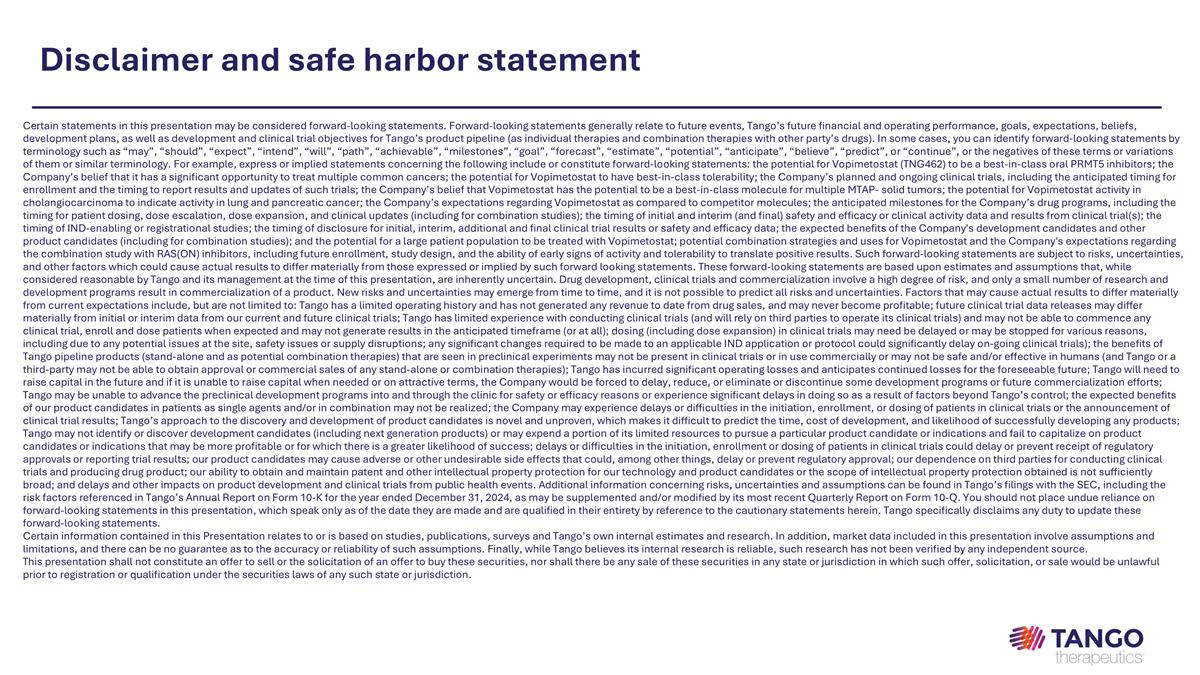
Disclaimer and safe harbor statement Certain statements in this presentation may be considered forward-looking statements. Forward-looking statements generally relate to future events, Tango’s future financial and operating performance, goals, expectations, beliefs, development plans, as well as development and clinical trial objectives for Tango’s product pipeline (as individual therapies and combination therapies with other party’s drugs). In some cases, you can identify forward-looking statements by terminology such as “may”, “should”, “expect”, “intend”, “will”, “path”, “achievable”, “milestones”, “goal”, “forecast”, “estimate”, “potential”, “anticipate”, “believe”, “predict”, or “continue”, or the negatives of these terms or variations of them or similar terminology. For example, express or implied statements concerning the following include or constitute forward-looking statements: the potential for Vopimetostat (TNG462) to be a best-in-class oral PRMT5 inhibitors; the Company’s belief that it has a significant opportunity to treat multiple common cancers; the potential for Vopimetostat to have best-in-class tolerability; the Company’s planned and ongoing clinical trials, including the anticipated timing for enrollment and the timing to report results and updates of such trials; the Company’s belief that Vopimetostat has the potential to be a best-in-class molecule for multiple MTAP- solid tumors; the potential for Vopimetostat activity in cholangiocarcinoma to indicate activity in lung and pancreatic cancer; the Company’s expectations regarding Vopimetostat as compared to competitor molecules; the anticipated milestones for the Company’s drug programs, including the timing for patient dosing, dose escalation, dose expansion, and clinical updates (including for combination studies); the timing of initial and interim (and final) safety and efficacy or clinical activity data and results from clinical trial(s); the timing of IND-enabling or registrational studies; the timing of disclosure for initial, interim, additional and final clinical trial results or safety and efficacy data; the expected benefits of the Company's development candidates and other product candidates (including for combination studies); and the potential for a large patient population to be treated with Vopimetostat; potential combination strategies and uses for Vopimetostat and the Company's expectations regarding the combination study with RAS(ON) inhibitors, including future enrollment, study design, and the ability of early signs of activity and tolerability to translate positive results. Such forward-looking statements are subject to risks, uncertainties, and other factors which could cause actual results to differ materially from those expressed or implied by such forward looking statements. These forward-looking statements are based upon estimates and assumptions that, while considered reasonable by Tango and its management at the time of this presentation, are inherently uncertain. Drug development, clinical trials and commercialization involve a high degree of risk, and only a small number of research and development programs result in commercialization of a product. New risks and uncertainties may emerge from time to time, and it is not possible to predict all risks and uncertainties. Factors that may cause actual results to differ materially from current expectations include, but are not limited to: Tango has a limited operating history and has not generated any revenue to date from drug sales, and may never become profitable; future clinical trial data releases may differ materially from initial or interim data from our current and future clinical trials; Tango has limited experience with conducting clinical trials (and will rely on third parties to operate its clinical trials) and may not be able to commence any clinical trial, enroll and dose patients when expected and may not generate results in the anticipated timeframe (or at all); dosing (including dose expansion) in clinical trials may need be delayed or may be stopped for various reasons, including due to any potential issues at the site, safety issues or supply disruptions; any significant changes required to be made to an applicable IND application or protocol could significantly delay on-going clinical trials); the benefits of Tango pipeline products (stand-alone and as potential combination therapies) that are seen in preclinical experiments may not be present in clinical trials or in use commercially or may not be safe and/or effective in humans (and Tango or a third-party may not be able to obtain approval or commercial sales of any stand-alone or combination therapies); Tango has incurred significant operating losses and anticipates continued losses for the foreseeable future; Tango will need to raise capital in the future and if it is unable to raise capital when needed or on attractive terms, the Company would be forced to delay, reduce, or eliminate or discontinue some development programs or future commercialization efforts; Tango may be unable to advance the preclinical development programs into and through the clinic for safety or efficacy reasons or experience significant delays in doing so as a result of factors beyond Tango’s control; the expected benefits of our product candidates in patients as single agents and/or in combination may not be realized; the Company may experience delays or difficulties in the initiation, enrollment, or dosing of patients in clinical trials or the announcement of clinical trial results; Tango’s approach to the discovery and development of product candidates is novel and unproven, which makes it difficult to predict the time, cost of development, and likelihood of successfully developing any products; Tango may not identify or discover development candidates (including next generation products) or may expend a portion of its limited resources to pursue a particular product candidate or indications and fail to capitalize on product candidates or indications that may be more profitable or for which there is a greater likelihood of success; delays or difficulties in the initiation, enrollment or dosing of patients in clinical trials could delay or prevent receipt of regulatory approvals or reporting trial results; our product candidates may cause adverse or other undesirable side effects that could, among other things, delay or prevent regulatory approval; our dependence on third parties for conducting clinical trials and producing drug product; our ability to obtain and maintain patent and other intellectual property protection for our technology and product candidates or the scope of intellectual property protection obtained is not sufficiently broad; and delays and other impacts on product development and clinical trials from public health events. Additional information concerning risks, uncertainties and assumptions can be found in Tango’s filings with the SEC, including the risk factors referenced in Tango’s Annual Report on Form 10-K for the year ended December 31, 2024, as may be supplemented and/or modified by its most recent Quarterly Report on Form 10-Q. You should not place undue reliance on forward-looking statements in this presentation, which speak only as of the date they are made and are qualified in their entirety by reference to the cautionary statements herein. Tango specifically disclaims any duty to update these forward-looking statements. Certain information contained in this Presentation relates to or is based on studies, publications, surveys and Tango’s own internal estimates and research. In addition, market data included in this presentation involve assumptions and limitations, and there can be no guarantee as to the accuracy or reliability of such assumptions. Finally, while Tango believes its internal research is reliable, such research has not been verified by any independent source. This presentation shall not constitute an offer to sell or the solicitation of an offer to buy these securities, nor shall there be any sale of these securities in any state or jurisdiction in which such offer, solicitation, or sale would be unlawful prior to registration or qualification under the securities laws of any such state or jurisdiction.
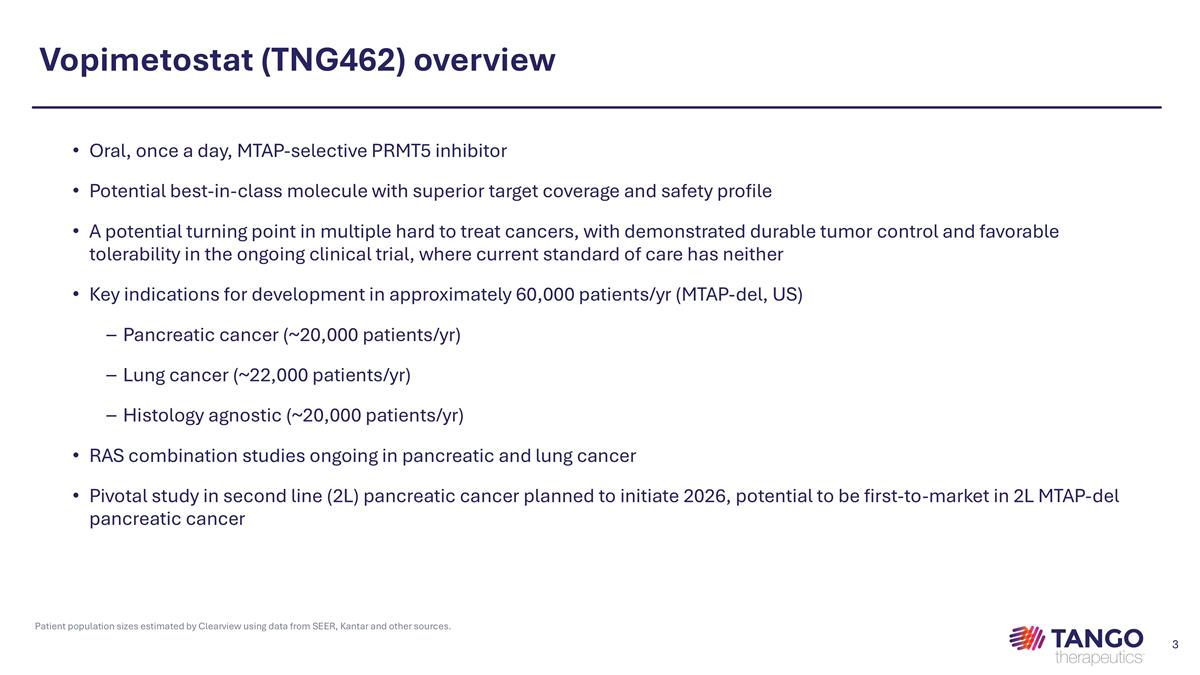
Vopimetostat (TNG462) overview Oral, once a day, MTAP-selective PRMT5 inhibitor Potential best-in-class molecule with superior target coverage and safety profile A potential turning point in multiple hard to treat cancers, with demonstrated durable tumor control and favorable tolerability in the ongoing clinical trial, where current standard of care has neither Key indications for development in approximately 60,000 patients/yr (MTAP-del, US) Pancreatic cancer (~20,000 patients/yr) Lung cancer (~22,000 patients/yr) Histology agnostic (~20,000 patients/yr) RAS combination studies ongoing in pancreatic and lung cancer Pivotal study in second line (2L) pancreatic cancer planned to initiate 2026, potential to be first-to-market in 2L MTAP-del pancreatic cancer Patient population sizes estimated by Clearview using data from SEER, Kantar and other sources.

Vopimetostat phase 1/2 study DOSE ESCALATION MTAP-del solid tumors DOSE OPTIMIZATION Pancreatic cancer Lung cancer Histology agnostic cancers All pancreatic cancers are adenocarcinomas. All lung cancers are non-small cell histology.
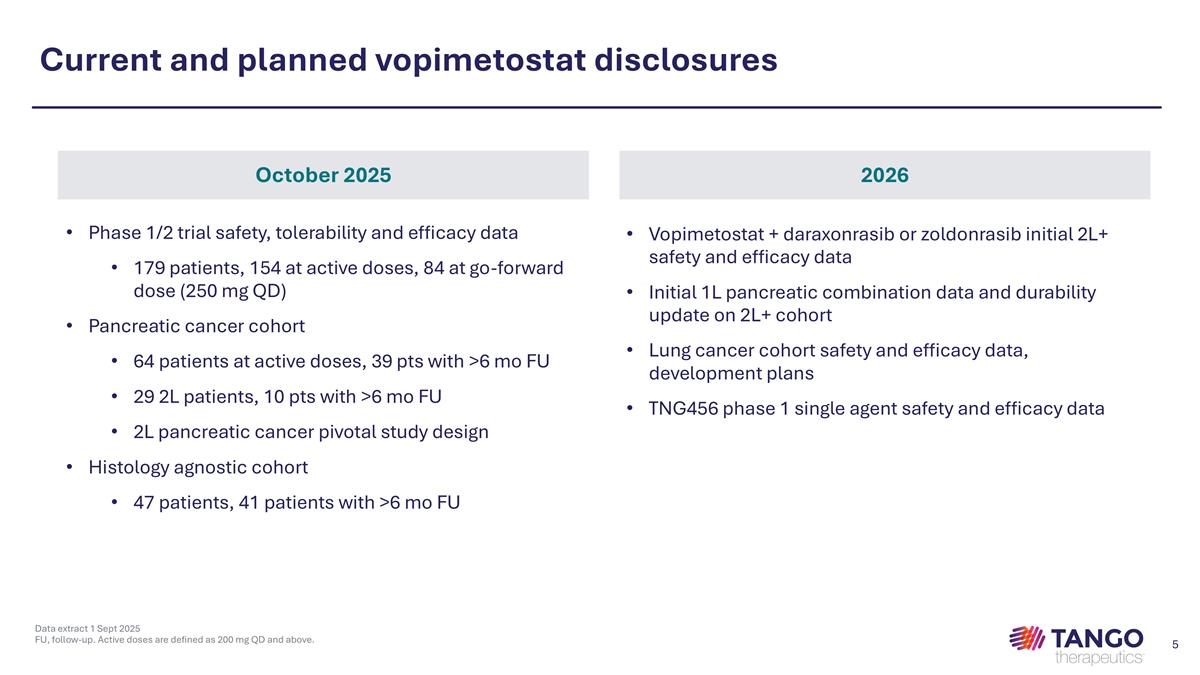
Current and planned vopimetostat disclosures Data extract 1 Sept 2025 FU, follow-up. Active doses are defined as 200 mg QD and above. October 2025 2026 Phase 1/2 trial safety, tolerability and efficacy data 179 patients, 154 at active doses, 84 at go-forward dose (250 mg QD) Pancreatic cancer cohort 64 patients at active doses, 39 pts with >6 mo FU 29 2L patients, 10 pts with >6 mo FU 2L pancreatic cancer pivotal study design Histology agnostic cohort 47 patients, 41 patients with >6 mo FU Vopimetostat + daraxonrasib or zoldonrasib initial 2L+ safety and efficacy data Initial 1L pancreatic combination data and durability update on 2L+ cohort Lung cancer cohort safety and efficacy data, development plans TNG456 phase 1 single agent safety and efficacy data
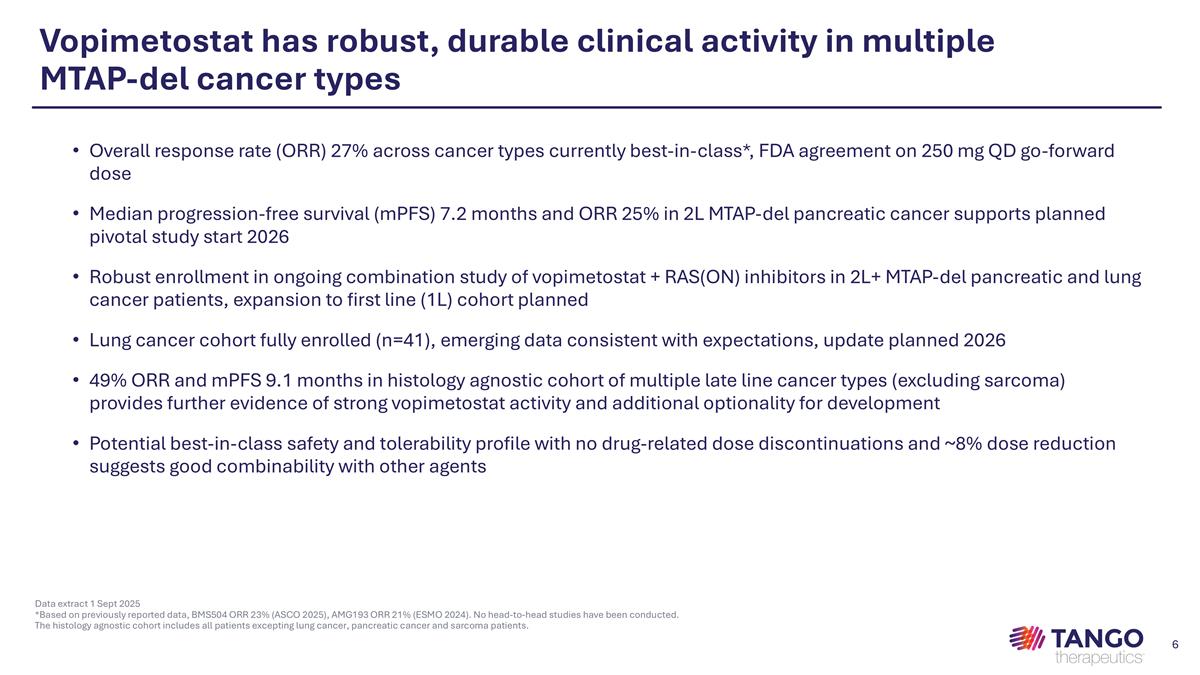
Vopimetostat has robust, durable clinical activity in multiple MTAP-del cancer types Overall response rate (ORR) 27% across cancer types currently best-in-class*, FDA agreement on 250 mg QD go-forward dose Median progression-free survival (mPFS) 7.2 months and ORR 25% in 2L MTAP-del pancreatic cancer supports planned pivotal study start 2026 Robust enrollment in ongoing combination study of vopimetostat + RAS(ON) inhibitors in 2L+ MTAP-del pancreatic and lung cancer patients, expansion to first line (1L) cohort planned Lung cancer cohort fully enrolled (n=41), emerging data consistent with expectations, update planned 2026 49% ORR and mPFS 9.1 months in histology agnostic cohort of multiple late line cancer types (excluding sarcoma) provides further evidence of strong vopimetostat activity and additional optionality for development Potential best-in-class safety and tolerability profile with no drug-related dose discontinuations and ~8% dose reduction suggests good combinability with other agents Data extract 1 Sept 2025 *Based on previously reported data, BMS504 ORR 23% (ASCO 2025), AMG193 ORR 21% (ESMO 2024). No head-to-head studies have been conducted. The histology agnostic cohort includes all patients excepting lung cancer, pancreatic cancer and sarcoma patients.
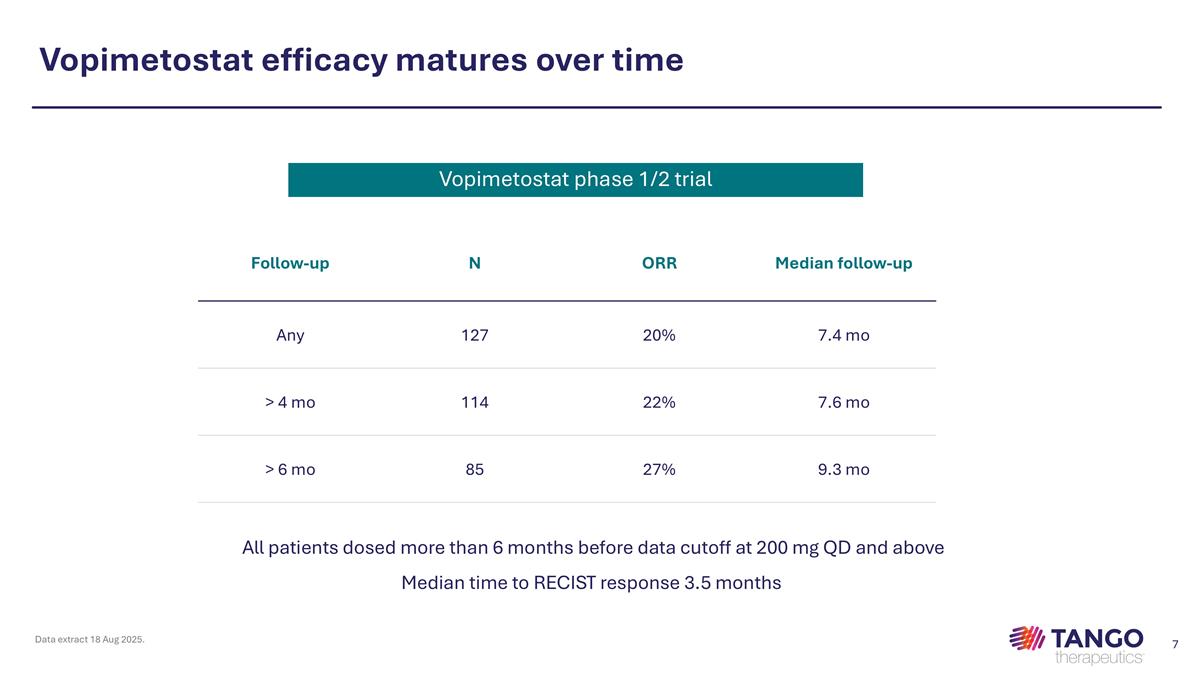
Vopimetostat efficacy matures over time Data extract 18 Aug 2025. Follow-up N ORR Median follow-up Any 127 20% 7.4 mo > 4 mo 114 22% 7.6 mo > 6 mo 85 27% 9.3 mo All patients dosed more than 6 months before data cutoff at 200 mg QD and above Median time to RECIST response 3.5 months Vopimetostat phase 1/2 trial
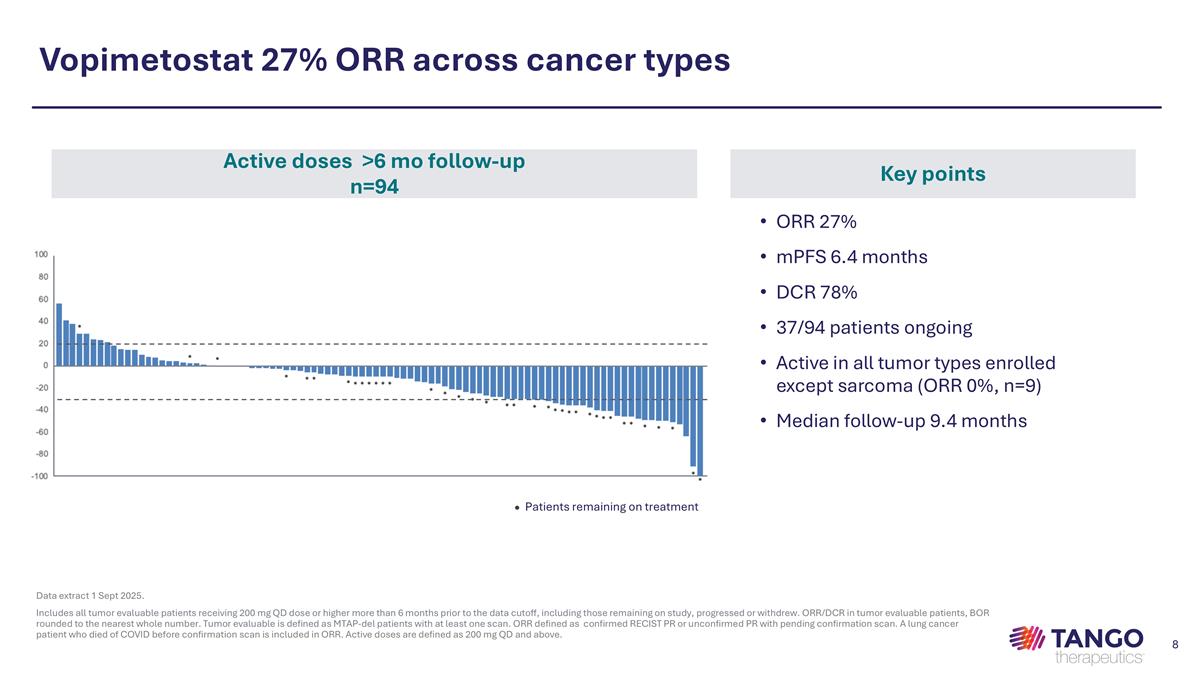
Vopimetostat 27% ORR across cancer types Data extract 1 Sept 2025. Includes all tumor evaluable patients receiving 200 mg QD dose or higher more than 6 months prior to the data cutoff, including those remaining on study, progressed or withdrew. ORR/DCR in tumor evaluable patients, BOR rounded to the nearest whole number. Tumor evaluable is defined as MTAP-del patients with at least one scan. ORR defined as confirmed RECIST PR or unconfirmed PR with pending confirmation scan. A lung cancer patient who died of COVID before confirmation scan is included in ORR. Active doses are defined as 200 mg QD and above. Active doses >6 mo follow-up n=94 Key points ORR 27% mPFS 6.4 months DCR 78% 37/94 patients ongoing Active in all tumor types enrolled except sarcoma (ORR 0%, n=9) Median follow-up 9.4 months Patients remaining on treatment ●
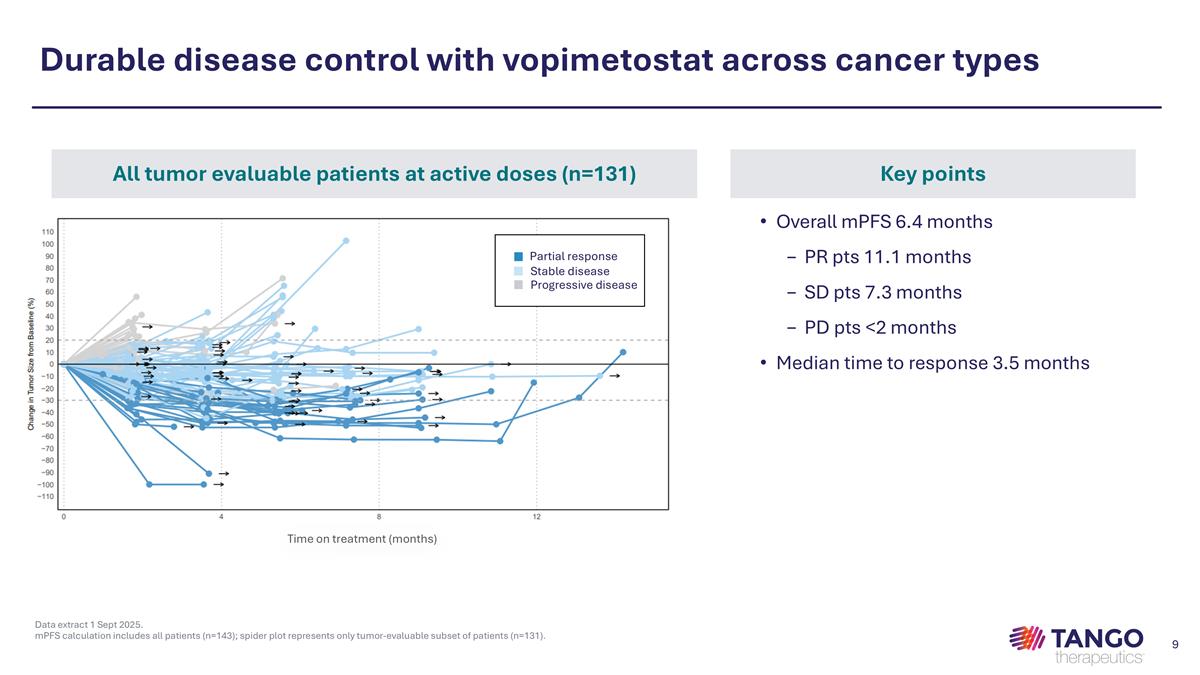
Durable disease control with vopimetostat across cancer types Data extract 1 Sept 2025. mPFS calculation includes all patients (n=143); spider plot represents only tumor-evaluable subset of patients (n=131). All tumor evaluable patients at active doses (n=131) Key points Overall mPFS 6.4 months PR pts 11.1 months SD pts 7.3 months PD pts <2 months Median time to response 3.5 months Time on treatment (months) Partial response Stable disease Progressive disease
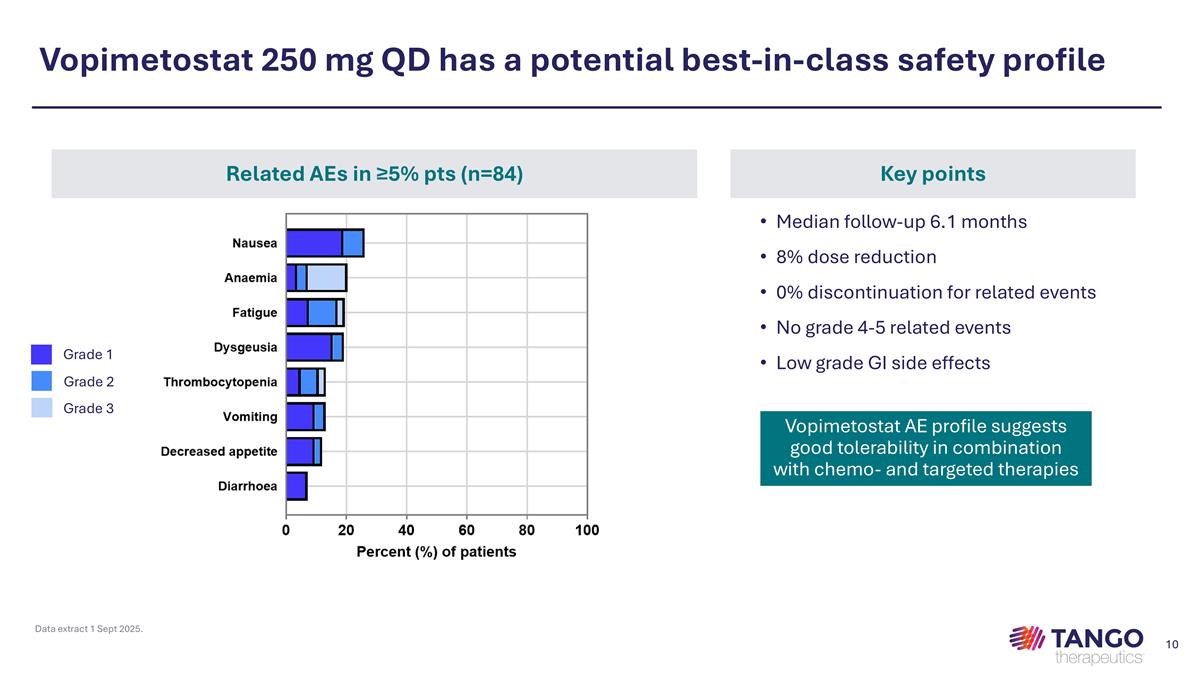
Vopimetostat 250 mg QD has a potential best-in-class safety profile Data extract 1 Sept 2025. Related AEs in ≥5% pts (n=84) Key points Median follow-up 6.1 months 8% dose reduction 0% discontinuation for related events No grade 4-5 related events Low grade GI side effects Vopimetostat AE profile suggests good tolerability in combination with chemo- and targeted therapies Grade 1 Grade 2 Grade 3
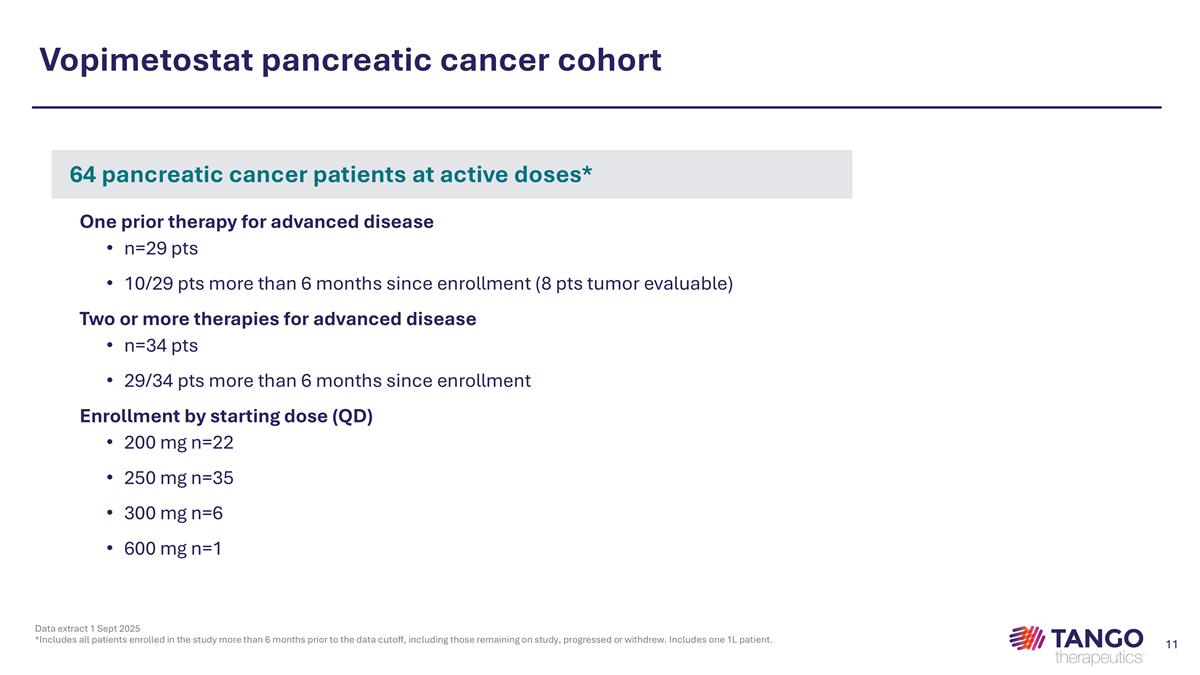
Vopimetostat pancreatic cancer cohort Data extract 1 Sept 2025 *Includes all patients enrolled in the study more than 6 months prior to the data cutoff, including those remaining on study, progressed or withdrew. Includes one 1L patient. 64 pancreatic cancer patients at active doses* One prior therapy for advanced disease n=29 pts 10/29 pts more than 6 months since enrollment (8 pts tumor evaluable) Two or more therapies for advanced disease n=34 pts 29/34 pts more than 6 months since enrollment Enrollment by starting dose (QD) 200 mg n=22 250 mg n=35 300 mg n=6 600 mg n=1
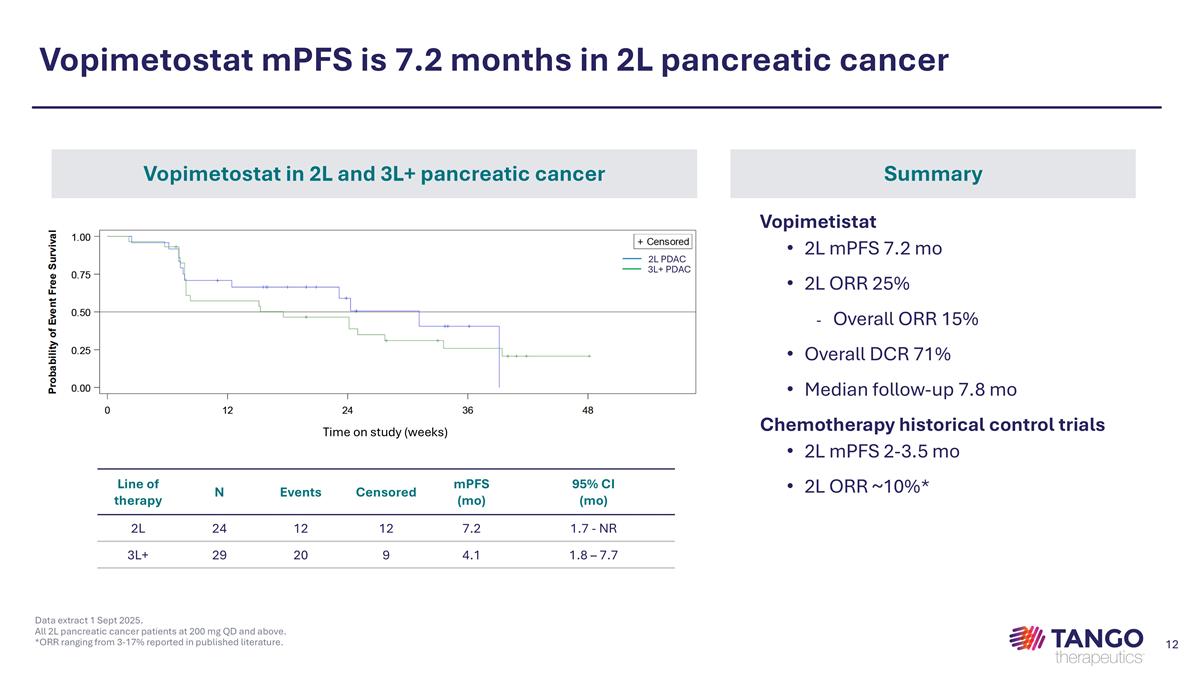
Vopimetostat mPFS is 7.2 months in 2L pancreatic cancer Data extract 1 Sept 2025. All 2L pancreatic cancer patients at 200 mg QD and above. *ORR ranging from 3-17% reported in published literature. Vopimetostat in 2L and 3L+ pancreatic cancer Summary Vopimetistat 2L mPFS 7.2 mo 2L ORR 25% Overall ORR 15% Overall DCR 71% Median follow-up 7.8 mo Chemotherapy historical control trials 2L mPFS 2-3.5 mo 2L ORR ~10%* Line of therapy N Events Censored mPFS (mo) 95% CI (mo) 2L 24 12 12 7.2 1.7 - NR 3L+ 29 20 9 4.1 1.8 – 7.7 Time on study (weeks) 2L PDAC 3L+ PDAC
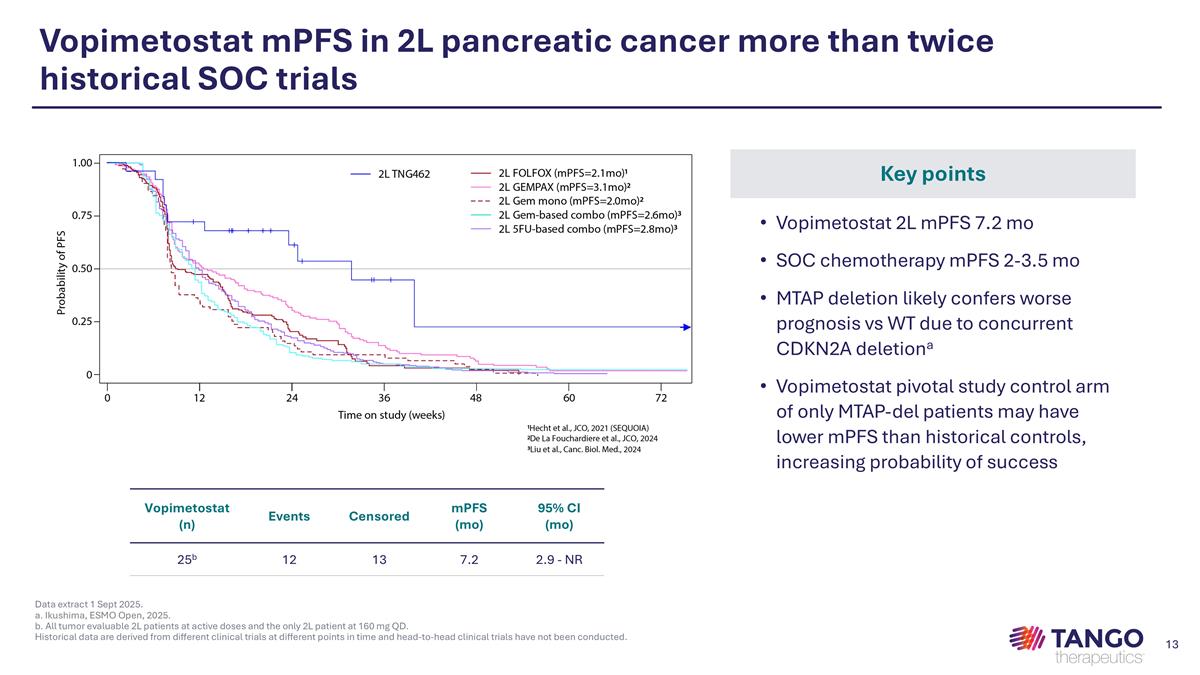
Vopimetostat mPFS in 2L pancreatic cancer more than twice historical SOC trials Data extract 1 Sept 2025. a. Ikushima, ESMO Open, 2025. b. All tumor evaluable 2L patients at active doses and the only 2L patient at 160 mg QD. Historical data are derived from different clinical trials at different points in time and head-to-head clinical trials have not been conducted. Key points Vopimetostat 2L mPFS 7.2 mo SOC chemotherapy mPFS 2-3.5 mo MTAP deletion likely confers worse prognosis vs WT due to concurrent CDKN2A deletiona Vopimetostat pivotal study control arm of only MTAP-del patients may have lower mPFS than historical controls, increasing probability of success Vopimetostat (n) Events Censored mPFS (mo) 95% CI (mo) 25b 12 13 7.2 2.9 - NR
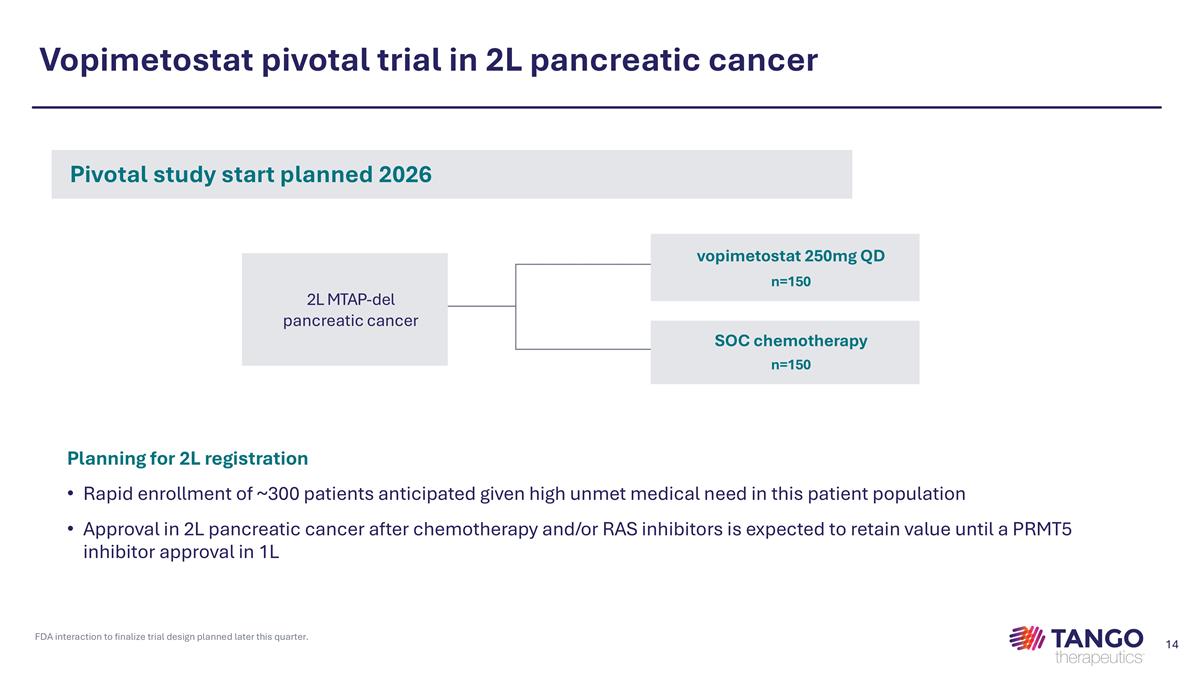
Vopimetostat pivotal trial in 2L pancreatic cancer Pivotal study start planned 2026 Planning for 2L registration Rapid enrollment of ~300 patients anticipated given high unmet medical need in this patient population Approval in 2L pancreatic cancer after chemotherapy and/or RAS inhibitors is expected to retain value until a PRMT5 inhibitor approval in 1L 2L MTAP-del pancreatic cancer vopimetostat 250mg QD n=150 SOC chemotherapy n=150 FDA interaction to finalize trial design planned later this quarter.

Vopimetostat + RAS(ON) inhibitors may provide chemotherapy free treatment for 1L MTAP-del pancreatic cancer Study update Cohort 1 complete (n=7) Exposures in active range for each compound Both combos well tolerated to date, early signs of activity Backfill ongoing with robust enrollment Cohort 2 enrollment ongoing 1L pivotal study planning RAS inhibitors are likely to change the standard of care in 1L pancreatic cancer Ongoing study has the potential to support a 1L pivotal study with shorter timelines than competitors DOSE ESCALATION Previously treated MTAP-del RAS mut cancers vopimetostat + daraxonrasib vopimetostat + zoldonrasib Any RAS mut G12D mut Safety and efficacy data update planned 2026
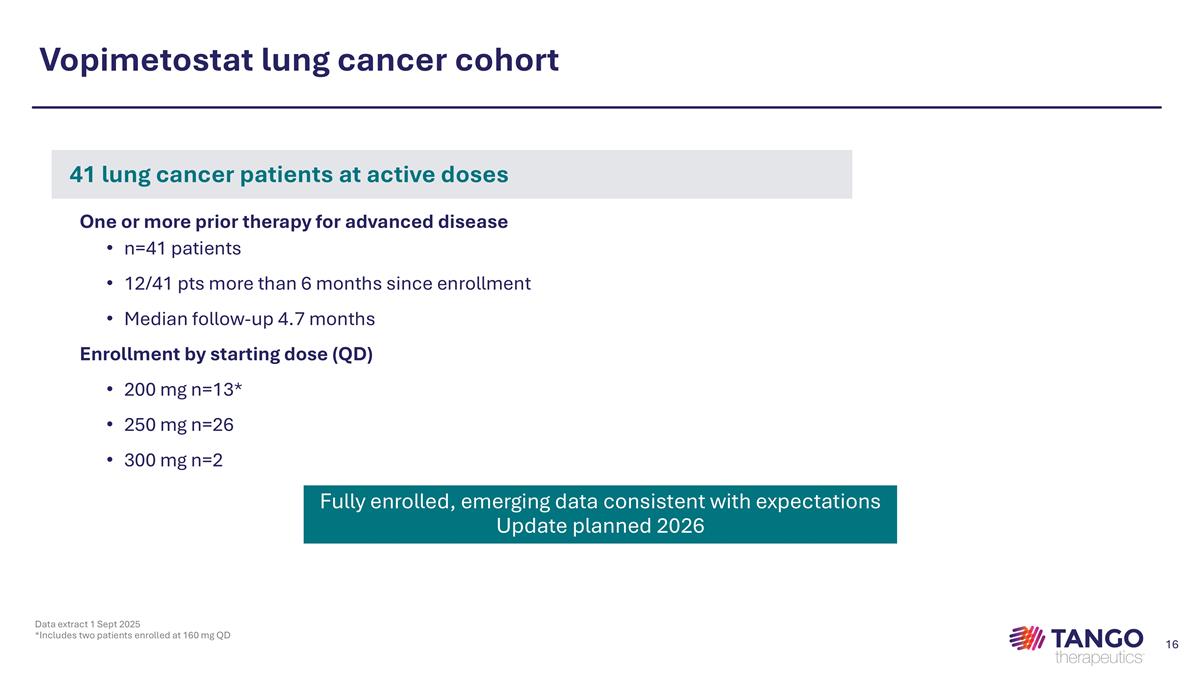
Vopimetostat lung cancer cohort 41 lung cancer patients at active doses One or more prior therapy for advanced disease n=41 patients 12/41 pts more than 6 months since enrollment Median follow-up 4.7 months Enrollment by starting dose (QD) 200 mg n=13* 250 mg n=26 300 mg n=2 Data extract 1 Sept 2025 *Includes two patients enrolled at 160 mg QD Fully enrolled, emerging data consistent with expectations Update planned 2026
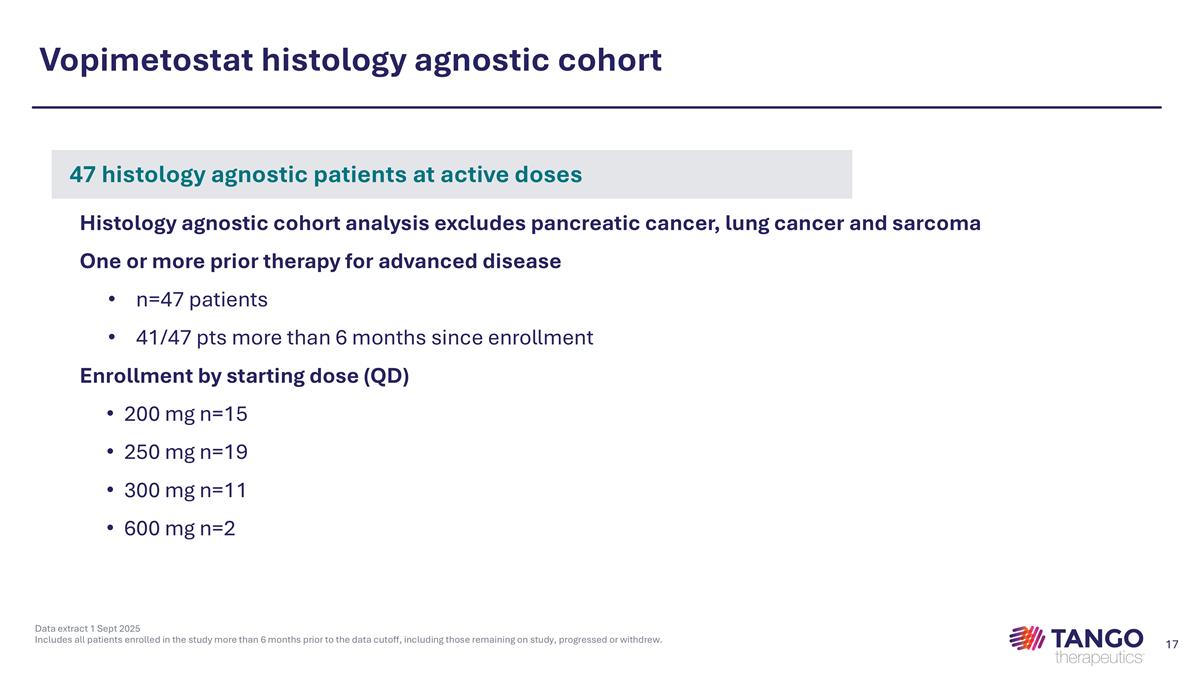
Vopimetostat histology agnostic cohort Data extract 1 Sept 2025 Includes all patients enrolled in the study more than 6 months prior to the data cutoff, including those remaining on study, progressed or withdrew. 47 histology agnostic patients at active doses Histology agnostic cohort analysis excludes pancreatic cancer, lung cancer and sarcoma One or more prior therapy for advanced disease n=47 patients 41/47 pts more than 6 months since enrollment Enrollment by starting dose (QD) 200 mg n=15 250 mg n=19 300 mg n=11 600 mg n=2
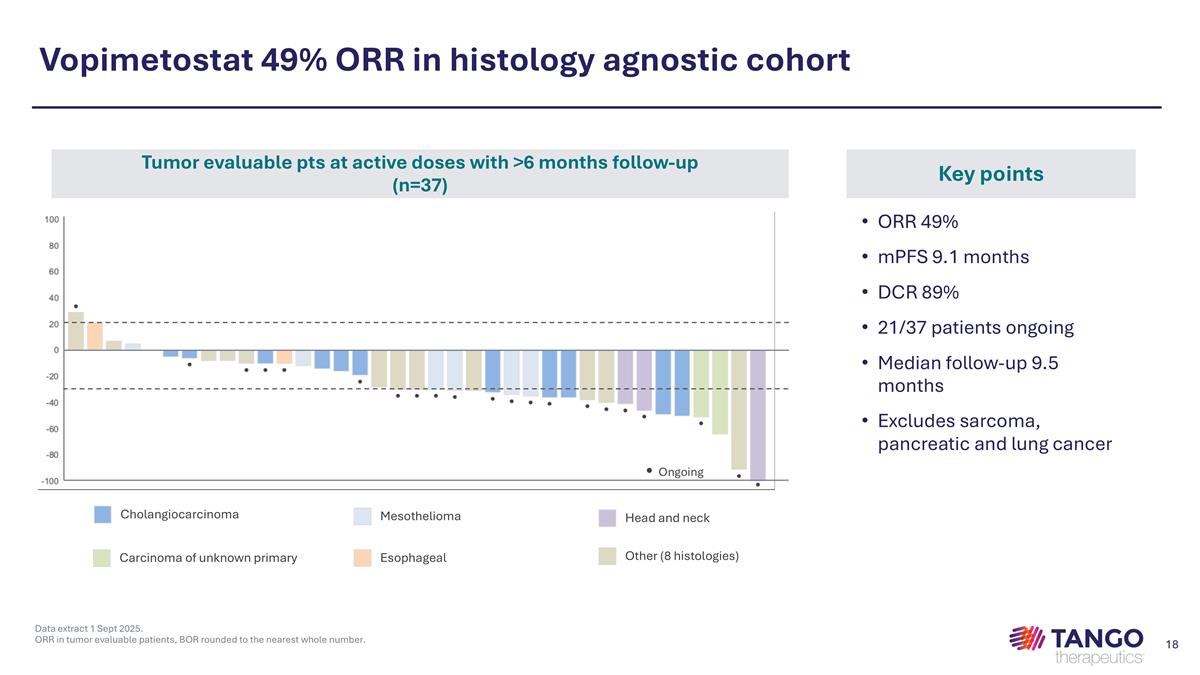
Vopimetostat 49% ORR in histology agnostic cohort Data extract 1 Sept 2025. ORR in tumor evaluable patients, BOR rounded to the nearest whole number. Tumor evaluable pts at active doses with >6 months follow-up (n=37) Key points ORR 49% mPFS 9.1 months DCR 89% 21/37 patients ongoing Median follow-up 9.5 months Excludes sarcoma, pancreatic and lung cancer Cholangiocarcinoma Mesothelioma Head and neck Carcinoma of unknown primary Esophageal Other (8 histologies) Ongoing ●
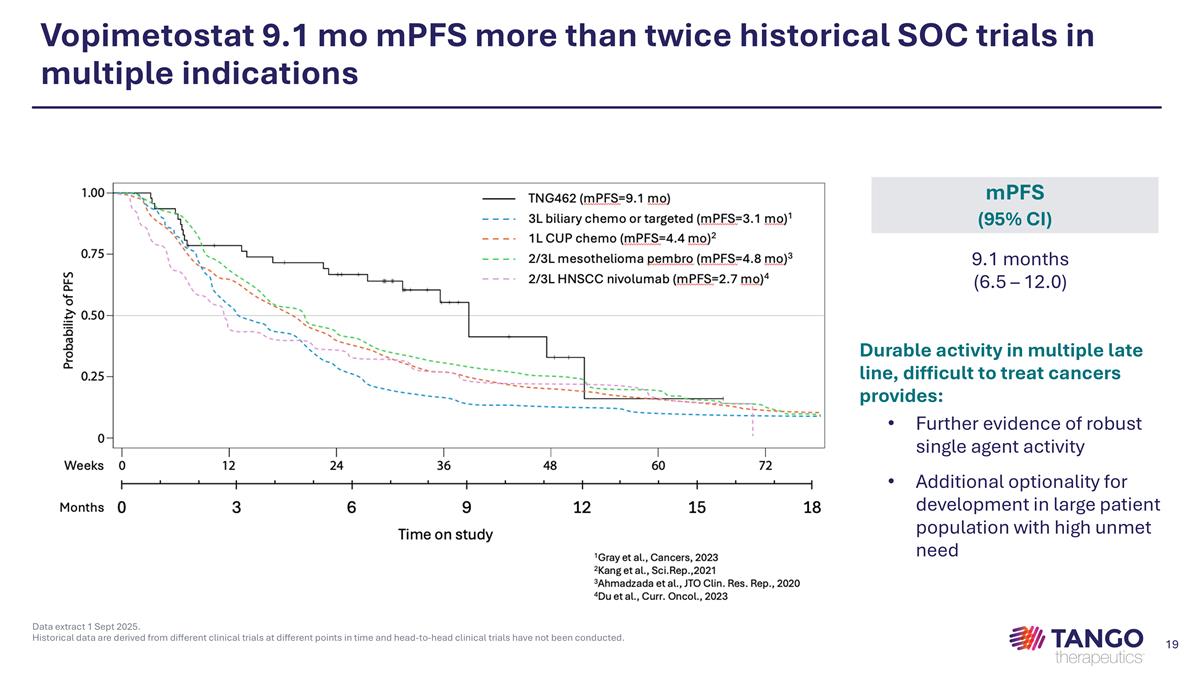
Vopimetostat 9.1 mo mPFS more than twice historical SOC trials in multiple indications mPFS (95% CI) 9.1 months (6.5 – 12.0) Durable activity in multiple late line, difficult to treat cancers provides: Further evidence of robust single agent activity Additional optionality for development in large patient population with high unmet need Data extract 1 Sept 2025. Historical data are derived from different clinical trials at different points in time and head-to-head clinical trials have not been conducted.
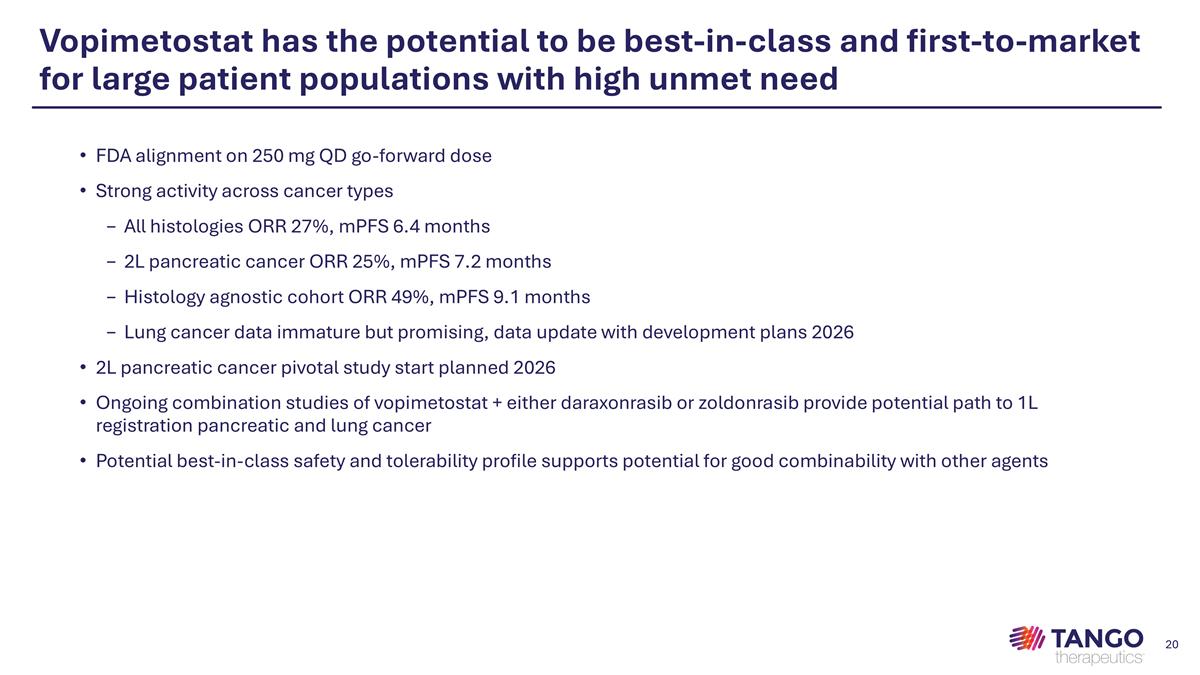
Vopimetostat has the potential to be best-in-class and first-to-market for large patient populations with high unmet need FDA alignment on 250 mg QD go-forward dose Strong activity across cancer types All histologies ORR 27%, mPFS 6.4 months 2L pancreatic cancer ORR 25%, mPFS 7.2 months Histology agnostic cohort ORR 49%, mPFS 9.1 months Lung cancer data immature but promising, data update with development plans 2026 2L pancreatic cancer pivotal study start planned 2026 Ongoing combination studies of vopimetostat + either daraxonrasib or zoldonrasib provide potential path to 1L registration pancreatic and lung cancer Potential best-in-class safety and tolerability profile supports potential for good combinability with other agents